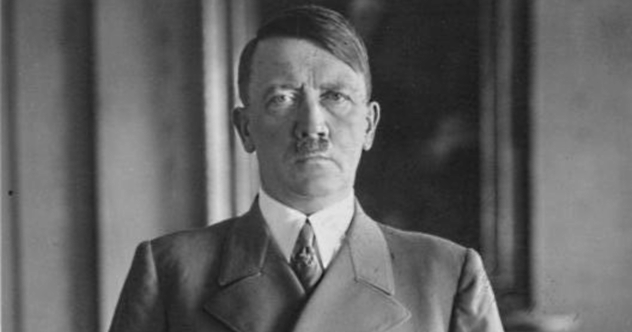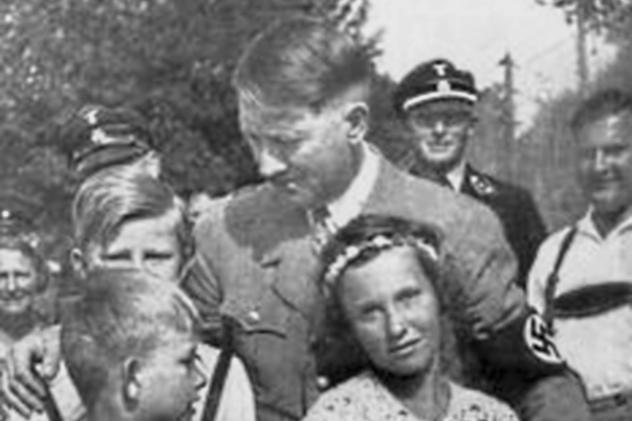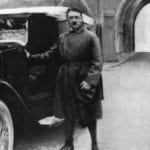 Mysteries
Mysteries  Mysteries
Mysteries  History
History 10 Surprising Stories About the Texas Rangers
 Humans
Humans 10 Philosophers Who Were Driven Mad by Their Own Theories
 Miscellaneous
Miscellaneous 10 Video-Game-Worthy Weapons and Armors from History
 Weird Stuff
Weird Stuff 10 Psychics Who Accurately Predicted Wartime Events
 The Arts
The Arts 10 Pieces of Art Inspired by a Broken Heart
 Health
Health 10 Science Fiction-Sounding New Medical Treatments
 History
History 10 Surprising Facts About the Father of Submarine Warfare
 Space
Space Ten Astonishing New Insights into Alien Worlds
 Weird Stuff
Weird Stuff 10 Bizarre Summer Solstice Rituals Still Practiced Today
 Mysteries
Mysteries Top 10 Haunting Facts About the Ghost Ship MV Alta
 History
History 10 Surprising Stories About the Texas Rangers
 Humans
Humans 10 Philosophers Who Were Driven Mad by Their Own Theories
Who's Behind Listverse?

Jamie Frater
Head Editor
Jamie founded Listverse due to an insatiable desire to share fascinating, obscure, and bizarre facts. He has been a guest speaker on numerous national radio and television stations and is a five time published author.
More About Us Miscellaneous
Miscellaneous 10 Video-Game-Worthy Weapons and Armors from History
 Weird Stuff
Weird Stuff 10 Psychics Who Accurately Predicted Wartime Events
 The Arts
The Arts 10 Pieces of Art Inspired by a Broken Heart
 Health
Health 10 Science Fiction-Sounding New Medical Treatments
 History
History 10 Surprising Facts About the Father of Submarine Warfare
 Space
Space Ten Astonishing New Insights into Alien Worlds
 Weird Stuff
Weird Stuff 10 Bizarre Summer Solstice Rituals Still Practiced Today
10 Bizarre Tales About Adolf Hitler
Without a doubt, Adolf Hitler is one of the most evil people to ever draw a breath . . . but he’s also one of the most fascinating people in all of human history. In fact, he’s such a compelling character that we’ve already published a list featuring 10 intriguing facts about “Der Fuhrer.” As it turns out, Hitler was such an insane and intriguing figure that we’ve rounded up 10 more bizarre stories about the mustachioed madman.
10 The Iconic Mustache

It’s difficult to imagine certain people without a mustache. Can you picture Hulk Hogan, Tom Selleck, or Salvador Dali without their trademark whiskers? Perhaps the most iconic (or infamous) mustache of all time belongs to Adolf Hitler. It’s almost impossible to picture the dictator without his trademark lip hair, and the look is so strongly associated with Adolf that growing a similar mustache is pretty much taboo.
So what’s the story behind Hitler’s mustache? Well, before we answer that question, we need to discuss what kind of soup-strainer Hitler actually sported. Many people refer to his lip hair as a “toothbrush mustache,” a style that originated in the US but became popular in Germany, mainly in response to the big, bushy mustaches made famous by the likes of Kaiser Wilhelm II. However, Brian Palmer of Slate points out that Hitler’s facial hair isn’t technically a toothbrush. “His whiskers were bushier and more narrow,” Palmer writes, “and, at best, could only be referred to as a ‘variant of the toothbrush style.’ ”
While the toothbrush itself was incredibly popular, fashion mavens thought Hitler’s knockoff variant was downright repulsive, describing his ‘stache as a “fly” or “snot brake.” Even Hitler’s own people tried to talk him into growing a longer set of whiskers, but the fuhrer brushed them off. He boldly declared, “If it’s not the fashion now, it will be later because I wear it.”
So when did Hitler first introduce his legendary look to the world? Some historians think that Hitler first sprouted his quasi-toothbrush in 1919 after Charlie Chaplin popularized the style for his “Little Tramp” character (although there’s no evidence to suggest that Hitler’s fashion sensibilities were actually inspired by Chaplin). However, recently found documents indicate that Hitler started wearing his “snot brake” during World War I . . . and it was all thanks to the British.
Hitler once sported a longer, fuller mustache, but he was forced to shave while fighting for the Motherland. During World War I, both the Allies and the Central Powers assaulted their enemies with poisonous gases, and unfortunately for Hitler, he couldn’t properly wear a respirator due to his facial hair. German officers ordered the soldier to trim his mustache, and that’s how the world’s wickedest set of whiskers was born.
9 The Story Of Hitler’s Stationery
It’s well-known that the CIA is a somewhat secretive institution. Even their museum is off-limits to everyone except CIA employees and their family members. That’s too bad for the rest of us because the museum is full of some pretty amazing artifacts, from 1960s spy gear to Osama bin Laden’s assault rifle. Mixed in with all of those Cold War gizmos, there’s an impressive piece of stationery marked with an Imperial Eagle, a swastika, and the name “Adolf Hitler.”
That’s right, the CIA owns a sheet of Hitler’s personal stationery. In fact, someone even used this particular piece of paper to write a message, but it’s all in English. So who dared to use Hitler’s stationery to write a personal letter? It was none other than Richard Helms, the director of the CIA from 1966–73. Helms wrote this letter back in 1945 when he was working for the OSS. After the fall of the Third Reich, this special agent actually crept into Hitler’s headquarters and snatched a sheet of paper, along with one of the dictator’s dishes (which is also in the CIA museum).
Helms then used Hitler’s stationery to write a touching note to his three-year-old son, Dennis. The letter was dated V-E Day (May 8, 1945) and said:
The man who might have written on this card once controlled Europe – three short years ago when you were born. Today he is dead, his memory despised, his country in ruins. He had a thirst for power, a low opinion of man as an individual, and a fear of intellectual honesty. He was a force for evil in the world. His passing, his defeat—a boon to mankind. But thousands died that it might be so. The price for ridding society of bad is always high. Love, Daddy.
It’s a pretty inspiring letter, although it does raise an interesting question. The letter was marked “V-E Day,” but Helms wasn’t in Germany on May 8, 1945. He was in France. Did he grab the stationery after May 8 but record the date as V-E Day to give his letter extra gravitas? It’s a mystery, but in 2011, Dennis donated the letter to the CIA. Amazingly, the stationery showed up at CIA headquarters one day after Osama bin Laden was killed, which is pretty amazing timing considering Helms’s message.
8 The Man Who Impersonates Hitler
In the past, we’ve read about some folks with unusual occupations, but those odd jobs pale in comparison to Emin Gjinovci’s weird way of making money. You see, Gjinovci is an impersonator . . . a Hitler impersonator.
Gjinovci found his curious calling during his time in the Kosovo Liberation Army in the 1990s. While fighting the Serbs, Gjinovci’s comrades noticed that he bore a striking resemblance to the famous German dictator, so they started calling him “Hitler.” After he was wounded during a battle, Gjinovci returned to his home country of Germany to receive medical attention. During his hospital stay, he grew a little mustache, and the staff started commenting on how he looked almost exactly like Adolf.
Sensing a business opportunity, Gjinovci began charging people for photos, and eventually, he turned his Hitler shtick into a never-ending act. Gjinovci brushes his hair like the dictator, keep his mustache trim, and carries “Hitler trinkets” wherever he goes. Specificially, Gjinovci constantly carries a copy of Mein Kampf, along with swastika badges and necklaces. Just like the dictator, Gjinovci never smokes. He even has Nazi business cards and often “performs” at weddings and funerals, though we’re not sure who would want Hitler showing up beside their casket.
People who encounter Gjinovci on the street often jokingly give him the “Heil Hitler” salute. Sadly, the actor might share some of the dictator’s more controversial ideas. According to a 1999 Guardian article, Gjinovci doesn’t approve of Hitler’s genocidal tendencies, but he wouldn’t mind using those same tactics on the Serbs, his sworn enemies. Let’s all hope “Kosovo’s own reincarnation of Adolf Hitler” stays in the entertainment business and out of politics.
7 He Features Prominently In A South African Cult
Bernard Poolman was a pretty unusual guy. A South African cop who became a software salesman (selling software that could allegedly cure ADHD), Poolman was obsessed with the occult. He claimed that the world was full of demons that needed defeating, and after allegedly exorcising a young man, Poolman launched an all-out spiritual war. According to the exorcist, he once battled 300 spirits at once, vanquishing them with the power of forgiveness.
Like we said, Bernard Poolman was a pretty unusual guy.
Poolman eventually turned his wacky theology into a full-fledged cult called Desteni. As the group’s new pastor, Poolman preached the importance of “self-forgiveness,” all while encouraging followers to take his online self-help classes which, naturally, cost a pretty penny. Graduates, who learn “essential life skills . . . such as self-forgiveness, writing, and self-correction application,” get a 35-percent cut by signing up new students. Yeah, Desteni is basically a big Ponzi scheme, only these con artists believe in a reptilian god named Anu and are always on the lookout for demonic forces.
So what does this have to do with Hitler? Well, the Desteni cult didn’t really get started until Poolman recruited a young waitress named Sunette Spies. According to Poolman, Spies was an “interdimensional portal” who could channel pretty much every influential figure who ever lived. If you want to talk to Audrey Hepburn, Kurt Cobain, or Friedrich Nietzsche, Spies has got you covered. Most importantly, Poolman claimed that she could channel Hitler.
You see, in Desteni “theology,” there’s a spirit realm where all the demons hang out, and Adolf Hitler is the Demon King. Well, he was, anyway, until Poolman and Jesus (yes, Jesus) invaded the demon world and took on all challengers. After defeating legions of evil spirits, Poolman fought the fuhrer himself, eventually defeating the dictator by—you guessed it—teaching him about the power of self-forgiveness.
Since that fateful battle, Hitler has appeared in quite a few Desteni videos (the cult has their own YouTube channel), where he lectures on all sorts of odd topics. It’s all courtesy of the interdimensional portal, Sunette Spies. While Poolman passed away in 2013, the Desteni cult is still around, preaching about forgiveness and chatting up the spirit of Adolf Hitler.
6 He’s A Superstar In Thailand
Neo-Nazis and Internet trolls aside, we can all agree that Hitler is a perfectly good choice to personify evil. Most people understand that admiring the fuhrer is generally frowned upon . . . unless you live in Thailand, of course. While the Western world views Hitler as a power-hungry psycho, Thailand has a slightly different take on the dictator. Since most Thai schools don’t teach about the Holocaust, many Thai teens view Hitler as a goofy hothead with a flair for flashy uniforms and impressive iconography.
That’s probably why, in 2011, a group of Thai high school students showed up at their annual summer sports day wearing SS uniforms, flying Nazi flags, and carrying fake machine guns while led by a woman dressed as Adolf. Things got weirder in 2013, when somebody opened a fried chicken joint called “Hitler,” complete with the fuhrer’s image on the sign.
Hot on the heels of the chicken incident, a group of art students painted a billboard with images of superheroes like Iron Man, Batman, the Hulk . . . and Hitler. There are also T-shirts. Evidently, Hitler T-shirts are all the rage in Thailand, especially shirts that portray the dictator as a cartoon panda, Ronald McDonald, or a pink Teletubby complete with a swastika antenna.
Once again, this can possibly be attributed to a gap in Thai education. (Similarly, many Westerners, including celebrities like ex-UFC champion Georges St. Pierre, are often unaware that many Asians are offended by the Japanese Rising Sun symbol.) However, things get a little more disturbing when you watch a 2014 propaganda video promoted by Prime Minister General Prayuth Chan-ocha. Meant to promote core Thai values, the movie includes a scene where the main character, a young student, is praised for painting a portrait of Hitler. Surely, Thai officials know about the Holocaust, which makes it all the more unsettling.
Of course, Thailand isn’t the only country with a weird view of Hitler. Taiwan, Hong Kong, and Japan have all been guilty in the past, and the same goes for India. Earlier this year, Indian ice cream vendors got into international hot water for selling “Hitler Ice Cream.” Even worse, Mein Kampf is one of the country’s best-selling books.
According to The Daily Beast, many Indian students aren’t taught about the Holocaust, similar to Thai students. Making things even more complicated, India has a troubled relationship with Great Britain. Since the Nazis opposed the UK during World War II, some 1940s Indian leaders actually supported Hitler’s regime. Perhaps some of those sentiments were passed down through the generations, but really, if you’re reading this list and don’t get all the Hitler hoopla, just trust us. It’s time to return that Hitler T-shirt.
5 The Hitler Nobody Knows

Even back in 1930s Germany, Adolf Hitler was a pretty unlikable guy. After all, he was an anti-Semitic rabble-rouser, an ex-con who’d tried to overthrow the government, and his Brownshirts had a bad habit of beating up political rivals. So when Hitler lost the 1932 presidential election, his team figured it was a good time to remake Hitler’s image, especially since his opponent (war hero Paul von Hindenburg) hadn’t won an absolute majority, and a run-off election was on the horizon.
Their goal was to turn Hitler into a lovable guy—no easy task. Fortunately for Hitler’s PR team, Heinrich Hoffman had the perfect solution. Hoffman was Hitler’s official photographer, and in 1932, he released the craziest coffee table book of all time, a photo album entitled The Hitler Nobody Knows. The book was full of quaint little pictures, starting off with photos of baby Hitler and his childhood home and leading up to his days as a World War I soldier and politician.
However, most of the photos purported to show an average day in the life of Adolf. Hoffman photographed Hitler traveling from political rally to political rally, meeting with the German people, and working tirelessly for the Motherland. Many pictures showed a tired Hitler resting between meetings or retiring to a simple dinner at the end of a hard day. Other photos showed Hitler surrounded by adoring children, feeding baby deer, or chilling with his beloved dogs. The accompanying text emphasized how Hitler epitomized “STRENGTH and GOODNESS” and that he was a “NON-DRINKER, NON-SMOKER, and VEGETARIAN.”
The photos showed Hitler in average Joe clothes in an effort to portray him as an everyman. Since Hitler was a drop-out, the book made a really big deal about how Hitler allegedly read every single book in his personal library, all 6,000 titles. But while Hitler didn’t win the run-off election (von Hindenburg would later appoint him as chancellor), the book was enormously popular, selling 400,000 copies in 1942 and endearing Hitler to the public, both at home and abroad.
US magazines helped out quite a bit, too. Publications like Vogue and the New York Times Magazine ran flattering pieces on the fuhrer, giving readers a tour of Hitler’s home and portraying him as a kindly country squire. One famous journalist named William George Fitz-Gerald wrote multiple articles for multiple magazines describing Hitler as a “shy, retiring man” who sported an “old tweed coat” and visited local villages to make sure the children were eating properly. Shockingly, some of these articles popped up just days before the Nazis invaded Poland and months after the world learned about Hitler’s animosity toward Jews.
Thanks to this massive PR push, Hitler fooled quite a few people into buying his benevolent leader gimmick, right up until the moment that the world went to war, and everyone found out the truth the hard way.
4 The Devil With Hitler
During World War II, Hollywood kept busy by churning out truckloads of propaganda. There were straightforward films like Frank Capra’s Why We Fight series and action movies like The Fighting Seabees. Then there was the weird stuff like Russian Rhapsody, a Warner Brothers cartoon where Russian gremlins frighten Hitler with a mask of Joseph Stalin. The weirdest propaganda flick to ever hit the silver screen was Hal Roach’s crazy comedy, The Devil with Hitler.
Released in 1942 as a 42-minute short, The Devil with Hitler begins with a business meeting in Hell. Evidently, the underworld is run by a board of directors who aren’t happy with the way that Satan, the chairman, is managing things. The Devil is clearly falling behind on the job because people just aren’t sinning enough these days. Frustrated, the board considers replacing their horned boss with someone who’s really nasty—Adolf Hitler.
When Satan learns what’s happening, he makes a demonic deal with the board. If he can convince Hitler to do one good deed, then the board will drop their plans to hire Adolf and keep the Devil as chairman. The rest of the film follows Satan as he tries to trick the fuhrer into performing a kind act. In spite of the Devil’s best efforts, Hitler sticks to his evil roots, forcing Satan to get creative.
Desperate, the Devil decides to impersonate the dictator and set a few prisoners free. However, things backfire when Hitler finds out and orders the recently freed prisoners executed. That’s when Satan locks Adolf in a munitions factory, threatening to blow up the building unless the fuhrer pardons the prisoners. Hitler agrees, thus performing a “good deed,” but the factory explodes anyway, sending Satan and Hitler straight to Hell.
When the two arrive in Satan’s lair, the board of directors is pretty impressed with the devil’s trickery and keeps him on as chairman. Feeling full of himself, Satan orders his henchmen to grab their pitchforks and give Hitler “the works,” and ta-da, that’s how the film ends.
Interestingly, the actor who played Hitler was Bobby Watson, a guy who appeared as Adolf in nine separate films. When The Devil with Hitler went to theaters, it played alongside a documentary about Japanese war crimes and a public service announcement calling for all good citizens to donate their scrap metal. However, this satanic short didn’t do all that well with critics. The New York Times claimed the film was “an affront to public taste and the public interest,” and it more or less disappeared from Hollywood history, sinking into cinematic Hell.
3 The Woman In Charge Of Hitler’s Teeth

In April 1945, the Soviets were moving into Berlin, and World War II was wrapping up. Hitler, hidden away in his bunker, knew it was only a matter of time before he was captured. Unwilling to fall into Russian hands, the dictator (and his partner Eva Braun) decided to escape the Soviets via suicide. After the deed was done, Hitler’s lackeys set their corpses on fire and buried the charred remains near the bunker, and that’s where Elena Rzhevskaya comes into the story.
A 25-year-old translator for the Red Army, Rzhevskaya specialized in interrogating German prisoners, but when the Soviets rolled into Berlin, she was tasked with a new assignment. Rzhevskaya, along with two other Russians, was ordered to track down the German chancellor. Thanks to an attentive soldier, the team found Hitler’s body a few days after his suicide. Well . . . they were pretty sure it was the fuhrer’s body, but they needed some rock-solid proof, and that involved checking Hitler’s teeth.
In spite of the cremation, Hitler’s jaws were in pretty good shape, and Rzhevskaya could use the dictator’s pearly whites to confirm his identity. In order to keep the teeth safe, Russian officials removed Hitler’s chompers, put them in a red jewelry box, and gave the grisly gift to Rzhevskaya for safekeeping. Armed with the jewelry box, the translator started to visit various hospitals and clinics, hoping to find Hitler’s dentist.
Eventually, she found the man’s office, only to learn that he’d skipped town. Fortunately, his assistant was pretty familiar with the geography of Hitler’s mouth and gave a vivid description of his teeth, a description that sounded like the teeth in Rzhevskaya’s box. Even better, the assistant produced Hitler’s X-rays and matched them up perfectly with the charbroiled jaws. Now it was official. Adolf Hitler was most definitely dead.
However, Joseph Stalin suppressed this new information and encouraged the idea that Hitler was still in hiding. As one of the only Soviets to know the truth, Rzhevskaya fought to tell her side of the story, but it wasn’t until 12 years later—with Khrushchev running the show—that she could finally tell her tale, publishing her version of events in a Soviet magazine.
Hitler’s body was eventually ground into powder and tossed into a river, a fitting ending for a diabolical despot.
2 The Millionaire Who Collects Hitler’s Belongings

Everyone has their own unusual interests, but sometimes passion evolves into full-fledged obsession. It’s probably safe to say Kevin Wheatcroft is totally obsessed with the Third Reich. A British millionaire, Wheatcroft has dedicated his life to pursuing a rather unsettling dream—to collect as much Nazi paraphernalia as possible.
For example, the man owns 88 World War II tanks, most of which belonged to the Nazis. He’s purchased U-boats and V-2 rockets, and he owns the world’s largest assortment of Kettenkrads, a sort of tank-motorcycle hybrid (pictured above). He possesses the biggest collection of Nazi musical instruments, and he owns more than a few SS uniforms and Wehrmacht weapons.
Any history buff would agree that this is all pretty cool, but during his travels around the world, Wheatcroft has purchased a few items that are more than a little unusual. These include a phone from the Buchenwald death camp, signed photos of Herman Goring, Eva Braun’s gramophone, and Josef Mengele’s grandfather clock.
That’s nothing compared to Wheatcroft’s obsession with Hitler. Using his vast amounts of cash, Wheatcroft bought the very door to the very prison cell where Hitler penned Mein Kampf. He purchased the Mercedes that Hitler rode into the Sudentenland back in 1938, and he’s so obsessed with the fuhrer that he once explored the ruins of the Berghof (Hitler’s home in the Bavarian Alps), where he retrieved some of Hitler’s wine racks. Also (brace yourselves), the man owns the largest collection of Hitler heads on the planet.
Wheatcroft has even turned his home into a shrine to Hitler memorabilia. If you wandered through his Leicestershire domicile, you’d spot some of Hitler’s motorcycles, a few Hitler dress suits, and quite a few of the dictator’s paintings. Most disturbing of all, when Wheatcroft hits the sack, he drifts off to dreamland in Hitler’s bed.
Contrary to his obsession, Wheatcroft says that he isn’t a Nazi or a Hitler supporter. So what’s his deal with the Third Reich? He told the Guardian:
I want to preserve things. I want to show the next generation of how it actually was. [ . . . ] It’s the sense of history you get from these objects, the conversations that went on around them, the way they give you a link to the past. It’s a very special feeling.
1 Hitler’s Taste Testers

Even though he was a bloodthirsty sort, Adolf Hitler wasn’t fond of meat. While some say he occasionally enjoyed sausage, he once famously declared eating meat was like devouring dead corpses, which is true, though a tad graphic. Hitler also claimed that vegetarianism might resurrect Aryan society, and that’s why he usually stuck to a diet of fruits and vegetables.
Near the end of his life, Hitler started worrying about the state of his salads. Growing increasingly paranoid, the fuhrer thought that the British were trying to poison his food, so he decided it was time to bring in a few food testers, 15 young women drafted into one of the worst jobs imaginable.
One of Hitler’s food testers was a 20-something named Margaret Woelk. Margaret absolutely hated Hitler and had even refused to join the female equivalent of the Hitler Youth. But that didn’t stop the Nazis from sending her to the “Wolfsshanze” (“Wolf’s Lair”), Hitler’s military compound located in modern-day Poland. There, her job usually involved keeping the kitchen books, but whenever Adolf showed up, she and her 14 comrades were ordered to eat the fuhrer’s food.
The routine was pretty simple . . . and terrifying. The women were led into a room where the fruits and veggies were spread out on a table. “The food was delicious,” Margaret later explained, “only the best vegetables, asparagus, bell peppers, everything you can imagine. And always with a side of rice or pasta.” Of course, the women couldn’t enjoy the meal, as they were constantly afraid of death by poison. If the food checked out, SS officers would box up the plates and deliver them to Hitler’s dining room.
During her two and a half years at the Wolf’s Lair, Margaret never saw Hitler, although she was there when Colonel Claus von Stauffenberg (played by Tom Cruise in Valkyrie) tried to blow the fuhrer to bits. After the failed assassination, the women were kept under close surveillance. Instead of letting the ladies return home each evening, the SS kept them locked in an abandoned schoolhouse near Hitler’s headquarters.
When the Soviets neared Berlin, a German lieutenant helped Margaret escape the compound, right before the Russians killed every other food tester. Tragically, Margaret was eventually captured and raped by the Soviets, but she survived her nightmare ordeal and reunited with her husband (who’d been drafted by the Nazis). However, Margaret kept her story a secret for most of her life. Fearing both persecution and prosecution, she didn’t admit the truth until she was 95. Really, who can blame her? When a psychotic dictator orders you to eat, or else, you pick up your salad fork and concentrate on one thing—survival.
Nolan Moore is a writer who hails from Texas. If you want, you can friend/follow him on Facebook, or you can send him an email.








